Beware of Conventional drugs used for treating asthma
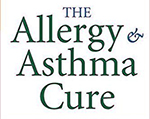 Dr. John Mills MD - "Conventional drugs used for treating asthma, particularly
steroids, can impair immune function and lead to more serious health problems.
"Doctors tell you that steroids (cortisone, prednisone) only cause side effects
after many years. But new research shows that permanent damage is immediate
and devastating. Studies show that steroids cause permanent, debilitating effects
after a single dosage. Steroids are probably the most sleazy of modern day medications"
John Mills, former professor of medicine at the University of California, San
Francisco and chief of infectious diseases at San Francisco General Hospital.
Dr. John Mills MD - "Conventional drugs used for treating asthma, particularly
steroids, can impair immune function and lead to more serious health problems.
"Doctors tell you that steroids (cortisone, prednisone) only cause side effects
after many years. But new research shows that permanent damage is immediate
and devastating. Studies show that steroids cause permanent, debilitating effects
after a single dosage. Steroids are probably the most sleazy of modern day medications"
John Mills, former professor of medicine at the University of California, San
Francisco and chief of infectious diseases at San Francisco General Hospital.
Dr. Lisa Landymore-Lim wrote all about this in her book "
Poisonous
Prescriptions"asking, ‘Do Antibiotics Cause Asthma and Diabetes?’ We are now even beginning to question
the role of antibiotics as a cause of cancer since they do lead to pathogen
overgrowth especially in the area of yeast and fungi. Chris Woollams writes,
“It is estimated that 70 per cent of the British population have a
yeast infection. The primary cause of this
is our love of antibiotics.
In the past few years heavy antibiotic use has been linked to the
inflammatory bowel disorder, Crohn's disease, and to children developing allergies such as hayfever and
asthma. An association between antibiotic exposure and
asthmais accepted both by the medical profession and the Department
of Social Security in the UK and the Health Department in Australia. However,
general practitioners and the general public are either apparently unaware of
this association, or have not drawn from it what I consider to be a logical
conclusion
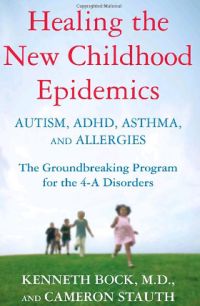 The FDA has recently called into question the safety of a popular allergy
and asthma drug, Singulair, after reports linked it to suicidal behavior and
mood changes. Over the course of the past year, the drug’s manufacturer, Merck,
changed the product labeling 4 times to include various warnings of side effects,
including tremors, anxiousness, depression, and suicidal behavior. The drug
currently pulls in $4.3 billion dollars in sales annually.
The FDA has recently called into question the safety of a popular allergy
and asthma drug, Singulair, after reports linked it to suicidal behavior and
mood changes. Over the course of the past year, the drug’s manufacturer, Merck,
changed the product labeling 4 times to include various warnings of side effects,
including tremors, anxiousness, depression, and suicidal behavior. The drug
currently pulls in $4.3 billion dollars in sales annually.
Asthma are abnormal inflammatory responses of the immune
system to dust, pollen, a food or some other substance. Those that involve an
antibody called immunoglobulin E (IgE) occur immediately or within an hour.
Reactions may include coughing, sneezing, runny nose, hives, diarrhoea, facial
swelling, shortness of breath, a swollen tongue, difficulty swallowing, lowered
blood pressure, excessive perspiration, fainting, anaphylactic shock or even
death.
Kenneth A. Bock, MD - "Allergies are adverse immune reactions to every
day substances that most people can tolerate. "Allergens," as they’re
called, can include inhalants such as pollens (e.g., ragweed), dust, cat hair or mold,
Allergens also are found in foods including wheat, peanut or egg. These two types of
allergens-food and inhalant-can join forces to increase your suffering.
Study links asthma with indoor swimming pools - Researchers
compared the rates of asthma in 13 and 14-year-old children in 21 European countries
and the number of chlorinated swimming pools per 100,000 people. They found
that after taking into account other factors such as climate, childhood asthma
and wheeze increased by 2-3 percent for every indoor swimming pool, according
the research published in the journal Occupational and Environmental Medicine.
According to Dr. Bock MD, deadly modern toxins,
nutritional deficiencies, metabolic imbalances, genetic vulnerabilities and assaults on
the immune and gastrointestinal systems trigger most of the asthma and allergy symptoms.

Food Allergies and Chemical Sensitivities Trigger Asthma
Asthma is notorious for being triggered by inhaled allergens but this does
not mean that such triggers are a basic cause of asthma. The main problem is
that there is an underlying chronic inflammation and oversensitivity of the
airways which then reacts indiscriminately to a wide range of inhaled irritants.
One common cause of a chronic inflammatory setting is the presence of hidden
food allergies.
 ‘Hidden’ means that people are not aware of the allergy because
usually the body does not react to an allergenic food to which it is exposed
every day. Most asthmatics have been shown to have such hidden food allergies.
The most common foods to which asthmatics react are cows’ milk and cheese, gluten,
eggs, nuts, and seafood. Drinking unpasteurized (raw) milk can protect children
against asthma and hayfever, according to a study of nearly 15,000 children
published in the May issue of Clinical and Experimental Allergy.
‘Hidden’ means that people are not aware of the allergy because
usually the body does not react to an allergenic food to which it is exposed
every day. Most asthmatics have been shown to have such hidden food allergies.
The most common foods to which asthmatics react are cows’ milk and cheese, gluten,
eggs, nuts, and seafood. Drinking unpasteurized (raw) milk can protect children
against asthma and hayfever, according to a study of nearly 15,000 children
published in the May issue of Clinical and Experimental Allergy.
The same applies to chemical sensitivities. The most common reactions for
asthmatics are caused by sulfur dioxide and sulfites (codes 221 to 224), by
monosodium glutamate or MSG (621 to 623), the yellow food dye tartrazine (code
102), and also salicylates such as aspirin. MSG is not necessarily declared
as such on a food label, it may just be called hydrolyzed vegetable protein,
vegetable or Thai seasoning or natural flavoring. All food additives are potentially
dangerous and best avoided, except a few such as vitamin C or citric acid. Medical
researchers think mainly in terms of inhaled allergens, but in response to a
study showing that cases of wheezing disorders in preschool children in the
UK doubled between 1990 and 1998 (The Lancet (Vol 357, p 1821), even they admit
that there must be other unknown factors present to explain this dramatic increase.
The immune system plays a central role in the health of the individual. It
protects us from disease by recognizing and eliminating or removing foreign
material from our bodies. Exposure to a variety of chemicals can effect this
system adversely; putting us at risk for illness and disease. Allergy is caused by an
oversensitive immune system, which leads to a misdirected immune response.
The immune system normally protects the body against harmful substances, such
as bacteria and viruses. In contrast, an allergic reaction is when the immune
system reacts to substances (allergens) that are generally harmless and in most
people do not cause an immune response.
Asthma and Allergies in Children - Dr. Doris Rapp M.D
Dr. Rapp is board certified in pediatrics and pediatric allergy. She was
a Clinical Assistant Professor of Pediatrics at the State University of New
York at Buffalo until January 1996. She practiced traditional allergy for 18
years and then, in 1975, began incorporating the principles of environmental
medicine in her pediatric allergy practice. She is a certified specialist in
Environmental Medicine. She has also produced numerous educational videos and
audiotapes for the public, educators and physicians. These demonstrate the dramatic
physical and behavioral changes in both children and adults that can be produced using a more precise method of
allergy testing called Provocation/Neutralization.
It has been estimated that about 90 million Americans suffer from food allergies especially
gluten sensitivity. According to a new study in the
Journal of Allergy and Clinical Immunology, there is a strong correlation between gluten intolerance
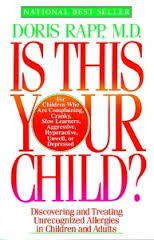 and asthma-
celiac disease confers
a 1.6-fold increased risk of asthma. Wheat and gluten are often a problem for those with asthma and hay fever.
If you have any problem with mucus, avoid all gluten products initially together with all
foods containing lactose. About 1.5 million Americans are thought to suffer from it.
and asthma-
celiac disease confers
a 1.6-fold increased risk of asthma. Wheat and gluten are often a problem for those with asthma and hay fever.
If you have any problem with mucus, avoid all gluten products initially together with all
foods containing lactose. About 1.5 million Americans are thought to suffer from it.
In her breakthrough book, Is This Your Child? - Dr. Rapp identifies the major symptoms of potentially
unrecognized allergies in children and adults, suggesting possible sensitivities
to dust, mold, pollen, foods or chemicals. Allergies are much more than high
fever, asthma and itchy skin. It is possible to identify allergies by simply
looking at someone. At times it is surprisingly easy to find and eliminate the
cause.
The typical clues of allergies and environmental illness can include any
combination of the following: Rubbing Nose Upwards; Eye Wrinkles; Dark Eye Circles
Sudden Aggression; Scarlet Earlobes A Spacey Look; Extreme Activity Changes
Wiggly Legs; Red Cheeks A Mottled Tongue.
Cow's milk allergy is the most common food allergy in young children. Fortunately,
most babies outgrow milk allergies by their second or third year. In the meantime,
parents of babies with milk allergies can be reassured that - although there
is no treatment that can cure milk allergies - symptoms can be controlled through
a dairy-free diet.
Today, supermarket milk is a brew of hormones, chemicals, DDT, fungicides,
defoliants and radioactive fallout, produced by artificially inseminated creatures
forced to stand around in muddy feed lots all day long.
Some Other Contributing Factors A headline in New
Scientist (19 July 2001) says “Margarine linked to dramatic asthma rise”. This
was a study of children in two rural Australian towns. Toddlers who consume
large amounts of margarine and foods fried in vegetable oil may be twice as
likely to develop asthma as others who eat less of these foods. This confirms
the well known fact that (omega-6) linoleic acid increases inflammatory tendencies;
this applies generally to polyunsaturated seed oils.
Finnish researchers came to a similar conclusion. They found that children
who eventually developed allergies ate less butter and more margarine compared
with children who did not develop allergies. Of course, health authorities have
been urging us for decades to consume more polyunsaturated fats and less saturated
fat thereby increasing the severity of asthma.
A study in the British Medical Journal (September 25, 1999; 319, 815-819)
shows that giving babies other milk than breast milk before the age of four
months greatly increases the risk of asthma and allergies. Children with low
birth weight of less than 1 kg in the US had an asthma rate of 21% compared
to 9% for children with higher birth weight.
Another New Scientist headline reads “Weekly swimming linked to lung damage”
(28 September 2001). This article reports that children who use chlorinated
swimming pools every week get lung damage just like smokers. Also lifeguards
who work in indoor pools have an increased incidence of asthma.
A surprising Japanese study found that school children who ate more fish
had also higher rates of asthma (Preventive Medicine February 2002;34:221-225).
As we know from other studies that fish oil and even consumption of oily fish
reduce inflammations and asthma, the conclusion is that in this case the high
rates of mercury in Japanese coastal waters are the cause of such fish causing
increased asthma. There are also various reports of vaccinations causing asthma.
One such case is described under the title: “A case of asthma after vaccination
against smallpox.” (Ekbom, K. .Acta Med Scand Suppl. 1966; 464:170-1).
Finish researchers found that mothers can
prevent eczema and asthma in their children by taking Probiotics
(acidophilus-bifido bacteria) while they are pregnant and breastfeeding. Babies
normally get their mother's bacteria as they travel down the birth canal, but
modern medicine is preventing this. Babies born by caesarian section are inoculated
with hospital bacteria such as Streptococci and Clostridia.

Studies Confirm Unvaccinated Children Have Less Asthma
In an article entitled "The Dark Side of Immunizations?," Science News reviews
new reports by researchers that show that vaccinated
children have a higher incidence of asthma and diabetes than do unvaccinated children . Science News
reports that a study by researchers at the Wellington School of Medicine in
New Zealand found that unvaccinated New Zealand children report fewer cases
of asthma than vaccinated children.
Another study by New Zealand researchers
published in the November 1997 Epidemiology analyzed the health of 1,265 people
born in 1977. Of these, 23 didn't get any childhood vaccinations and none of
them suffered childhood asthma. Among the 1,242 who got polio and DPT shots,
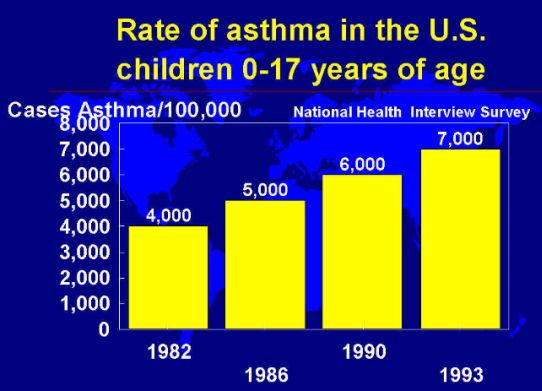 more
than 23 percent later had episodes of asthma. Science News adds that a 1994
survey of 446 British children, most of them eight years old, showed that 91
received no vaccinations in early childhood. Only one child out of 91 got asthma.
About 11 percent of the other 355 children who had been vaccinated with pertussis
and other vaccines had asthma.
more
than 23 percent later had episodes of asthma. Science News adds that a 1994
survey of 446 British children, most of them eight years old, showed that 91
received no vaccinations in early childhood. Only one child out of 91 got asthma.
About 11 percent of the other 355 children who had been vaccinated with pertussis
and other vaccines had asthma.
Several asthma and allergy researchers have found results similar to the
earlier described relationship between immunization and IDDM. A group from New
Zealand (Kemp, Pearce, Fitzharriset al.1997) found that asthma and allergies
were more common in children that received pertussis vaccine than in those that
were not immunized. Similar results have been suggested by others (Odent, Culpin &
Kimmel, 1994) . More recently Dr. Julian Hopkin presented data at the British
Thoracic Society meeting in 1997 which linked asthma to immunization. He has
also published data that early immunization with BCG in Japan is associated
with a decreased risk of IDDM (Shirakawa, Enomoto, Shimazuet al.1997).
Athma, Allergies and Vaccines
 Several asthma and allergy researchers have found results similar to the earlier
described relationship between immunization and IDDM. A group from New Zealand
(Kemp, Pearce, Fitzharriset al.1997) found that asthma and allergies were more
common in children that received pertussis vaccine than in those that were not
immunized. Similar results have been suggested by others (Odent, Culpin and
Kimmel, 1994) . More recently Dr. Julian Hopkin presented data at the British
Thoracic Society meeting in 1997 which linked asthma to immunization. He has
also published data that early immunization with BCG in Japan is associated
with a decreased risk of IDDM (Shirakawa, Enomoto, Shimazuet al.1997).
Several asthma and allergy researchers have found results similar to the earlier
described relationship between immunization and IDDM. A group from New Zealand
(Kemp, Pearce, Fitzharriset al.1997) found that asthma and allergies were more
common in children that received pertussis vaccine than in those that were not
immunized. Similar results have been suggested by others (Odent, Culpin and
Kimmel, 1994) . More recently Dr. Julian Hopkin presented data at the British
Thoracic Society meeting in 1997 which linked asthma to immunization. He has
also published data that early immunization with BCG in Japan is associated
with a decreased risk of IDDM (Shirakawa, Enomoto, Shimazuet al.1997).
The culprit behind
asthma and allergies: vaccination A summary of published medical research
findings pertaining to the atopic effect of vaccination. Appears here as published
in New Vegetarian and Natural Health Magazine, Winter 2000 issue.
Can vaccines cause immune dysfunction resulting in allergies, asthma and anaphylaxis?
Several asthma and allergy researchers have found results similar to the earlier
described relationship between immunization and IDDM. A group from New Zealand
(Kemp, Pearce, Fitzharriset al.1997) found that asthma and allergies were more
common in children that received pertussis vaccine than in those that were not
immunized. Similar results have been suggested by others (Odent, Culpin and
Kimmel, 1994) . More recently Dr. Julian Hopkin presented data at the British
Thoracic Society meeting in 1997 which linked asthma to immunization. He has
also published data that early immunization with BCG in Japan is associated
with a decreased risk of IDDM (Shirakawa, Enomoto, Shimazuet al.1997).
The Institute of Medicine's Immunization Safety Review Committee held a public
meeting in Seattle, Washington on November 12, 2001 to review the "Possible
association between multiple immunizations in newborns and infants and immune
system dysfunction." The Institute of Medicine Report stated... "The committee
looked at five studies examining multiple vaccinations and their potential to
cause allergic diseases, which reflect a hypersensitivity of the immune system
to relatively harmless agents in the environment, like pollens, dust mites,
insect venom, and specific foods. Some, but not all, of these studies suggested
that certain vaccines increase the risk of developing allergic disorders. Methodological
weaknesses and inconsistent findings among the studies, however, led the committee
to conclude that there is inadequate evidence to either accept or reject a causal
relationship between multiple immunizations and increased risk of allergic diseases,
particularly asthma."
Why the "surge" in anaphylactic children entering school a decade ago? These
children were among the first to receive an additional vaccination, Hib meningitis.
Is it possible that the Pertussis and Hib vaccine, both shown below to cause
allergic responses, are creating a hypersensitive immune system in some children?
Has any study looked into what happens to atopy incidence and IgE levels when
5 vaccines are given concurrently in infants?
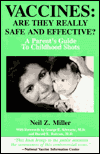 Possible
association between multiple immunizations in newborns and infants and immune
system dysfunction
Possible
association between multiple immunizations in newborns and infants and immune
system dysfunction
The exact numbers of children affected by anaphylaxis are difficult to pinpoint.
A study in Arch Intern Med 2001 Jan 8;161(1):15-2, Anaphylaxis in the United
States: an investigation into its epidemiology, concluded with "The occurrence
of anaphylaxis in the US is not as rare as is generally believed. On the basis
of our figures, the problem of anaphylaxis may, in fact, affect 1.21% (1.9 million)
to 15.04% (40.9 million) of the US population."PMID
11146694
Pediatr Res 1987 Sep;22(3):262-7 Murine responses to immunization with pertussis
toxin and bovine serum albumin: I. Mortality observed after bovine albumin challenge
is due to an anaphylactic reaction..........the results of our experiments have
established that the disease induced by co immunizing mice with Ptx and BSA is
due to an immediate type hypersensitivity.

Natural Remedies for the Relief of Asthma and Allergies
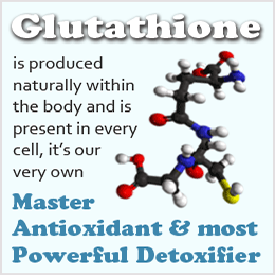 Increasing glutathione levels in the lungs may be beneficial in lung disease.
Although there are few studies using glutathione
(GSH) enhancement therapies or nebulized (aerosolized and inhaled) glutathione
in lung diseases, there is good data (mostly in animal models) suggesting increasing
the potent antioxidant and free-radical scavenger glutathione would be beneficial
in certain degenerative lung conditions associated with increased free radical
load including asthma, cystic fibrosis, bronchiectasis and
bronchiolitis obliterans.
Increasing glutathione levels in the lungs may be beneficial in lung disease.
Although there are few studies using glutathione
(GSH) enhancement therapies or nebulized (aerosolized and inhaled) glutathione
in lung diseases, there is good data (mostly in animal models) suggesting increasing
the potent antioxidant and free-radical scavenger glutathione would be beneficial
in certain degenerative lung conditions associated with increased free radical
load including asthma, cystic fibrosis, bronchiectasis and
bronchiolitis obliterans.
The Homeopathic Treatment of Asthma
Homeopaths have a long history of successful allergy treatment, and they
have made some important contributions to present understanding of allergies.
Sir William Osler, considered the Father of Modern Medicine, was known to
say, "Asthmatics don't die, they just 'pant into old age.'" However, new research
on the homeopathic treatment of asthma that has been published in The Lancet
(December 10, 1994) suggests that relief is in sight for asthma sufferers.
Research conducted by professors at the University of Glasgow, Europe's largest
medical school, indicates that those patients given an exceedingly small homeopathic
doses of whatever substance to which they are most allergic can provide significant
relief within the first week of treatment. The authors called this unique method
of individualizing medicines "homeopathic immunotherapy."
This double-blind, placebo-controlled trial showed that over 80% patients
given a homeopathic remedy improved, while only 38% of patients given a placebo
experienced a similar degree of relief. The patients were assessed by a homeopathic
physician and a conventional physician. When the patients and doctors were asked
if they felt the patient received the homeopathic medicine or the placebo, both
the patients and the doctors tended to guess correctly.
How Can Homeopathy Help Asthma? Like with Traditional Chinese Medicine, each
individual is analyzed for their specific symptoms and an appropriate therapy
is chosen, not for the disease, but for the person displaying signs of health
out of balance. This is a very important distinction, and, very generally speaking,
one of the main differences between conventional and "complementary" approaches
to health care. Please refer to the essay on Homeopathy in the Introduction
to Modalities section. American Association of Naturopathic Physicians
"Homeopathic remedies are prescribed on an individual basis so that specific
imbalances can be focused on and resolved. They work similar in action to a
vaccine- in that a small amount of a substance stimulates the healing mechanisms
of the immune system. The beauty of homeopathic treatment is that there are
no worries about toxic side effects, relatively inexpensive, and works to repair
the immune system and other imbalances in the body. Recent clinical studies
have confirmed the effectiveness of homeopathic medicine in the treatment of
asthma." Mark Stengler ND
Treatment of Allergies with Homeopathy
Dana Ullman, M.P.H.
Solid research have proven the effectiveness of homeopathic medicines in
hayfever. Dr. David Taylor-Reilly, a professor and homeopath at the University
of Glasgow in Scotland, published an important study in the Lancet (October
18, 1986) which showed that homeopathically prepared doses of 12 common flowers
were very effective in reducing hayfever symptoms when compared with patients
given a placebo. This same researcher published in the Lancet (12-10-94) another
high caliber study on the homeopathic treatment of asthma. This double-blind,
placebo-controlled randomized trial performed conventional allergy testing to
determine what substance asthma sufferers were most allergic. Then, half of
the subjects were given a homeopathic preparation of this substance, while the
other half were given a placebo. Those people given the homeopathic medicine
experienced a very significant improvement in their symptoms of asthma.

Asthma and Magnesium Deficiency
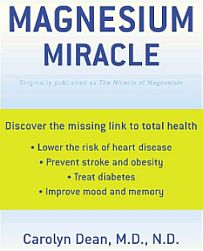 A population-based clinical study of over 2,500 children aged 11 - 19 years found
that low dietary magnesium intake may be associated with a risk of developing
asthma. The same was found in a group of over 2,600 adults aged 18 - 70. In
addition, some clinical studies suggest that intravenous and inhaled magnesium can help treat acute attacks of asthma in children
aged 6 - 18 as well as adults. However, evidence from other clinical studies
report that long-term oral magnesium supplementation does not lead to improved
control in adult asthma.
A population-based clinical study of over 2,500 children aged 11 - 19 years found
that low dietary magnesium intake may be associated with a risk of developing
asthma. The same was found in a group of over 2,600 adults aged 18 - 70. In
addition, some clinical studies suggest that intravenous and inhaled magnesium can help treat acute attacks of asthma in children
aged 6 - 18 as well as adults. However, evidence from other clinical studies
report that long-term oral magnesium supplementation does not lead to improved
control in adult asthma.
Glyconutrients - Phytoplankton Nutritional Support for Asthma
 Major universities are involved in the
study of glyconutrients. Academic institutions
throughout the United States now have laboratories focusing on glycobiology
research, including the University of California, University of Oklahoma, San
Francisco State University, University of Wisconsin, The Burnham Institute,
The Scripps Research Institute, and the Massachusetts Institute of Technology.
The focus of their research involves a wide range of possible uses including
cancer treatments, anti-inflammatory and anti-fungal agents as well as treatments
for influenza, asthma, and other infections.
Major universities are involved in the
study of glyconutrients. Academic institutions
throughout the United States now have laboratories focusing on glycobiology
research, including the University of California, University of Oklahoma, San
Francisco State University, University of Wisconsin, The Burnham Institute,
The Scripps Research Institute, and the Massachusetts Institute of Technology.
The focus of their research involves a wide range of possible uses including
cancer treatments, anti-inflammatory and anti-fungal agents as well as treatments
for influenza, asthma, and other infections.
"Chelsea is 8 years old and has had severe food allergies and asthma her entire
life. Last week she went to the doctor to refill her inhalant prescription for
her asthma. He asked her to take deep breaths, and by the fifth one she needed
the inhaler because she was wheezing so badly. The day after the visit, Chelsea
began to take half an ounce of Marine Phytoplankton
daily added to her juice.
After a week, she was able to endure over an hour
of exercise on a trampoline without the use of her asthma medication, which
would not have been possible a week prior. She visited the doctor again today
and he said he could not explain why she was no longer wheezing and has reduced
her need for the inhaler from several times a day to two times a day. Because
of Marine Phytoplankton, her moods have significantly improved and she seems
to be feeling much happier!" V. G.

Asthma and Emphysema
population-based study of over 2,500 children aged 11 to 19 years found that
low dietary magnesium intake may be associated with
a risk of developing asthma. The same was found in a group of over 2,600 adults
aged 18 to 70. In addition, some studies suggest that intravenous magnesium
can help treat acute attacks of asthma in children aged 6 to 18 as well as adults.
This may also be true for those with emphysema (also known as chronic obstructive
pulmonary disease or COPD). A doctor will determine if this is necessary and
appropriate in a hospital setting.
Pollen is also a remedy for hay fever and allergies. However it must be taken
at least six weeks before the season begins and then continued throughout the
season if it going to work.
Bee pollen has been effectively used down through the ages to rid allergy
sufferers of their afflictions.
Bee Pollen Treats Allergies
This technique, called desensitization, was
developed at St. Mary's Hospital Medical School in London soon after the turn
of the century. The treatment consists of administering small amounts of the
allergen to stimulate the patient's own immune system to produce antibodies
that will eliminate the allergic reaction. It works rather like a vaccination
does against childhood diseases. Desensitization is based on the premise that
the administration of the allergen will cause the body to produce antibodies
that will cancel out the effects of the offending substance when the patient
is again exposed to it.